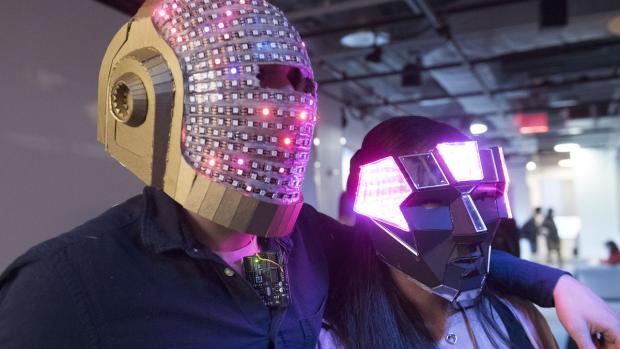The work of Tandon’s Integrated Digital Media students wowed at the 2019 IDM Showcase

On May 17, more than 100 projects created by students in Tandon’s Integrated Digital Media (IDM) program were showcased to the public, and if ever proof were needed that Brooklyn sits directly at the intersection of technology and art, the event provided it.
The Integrated Digital Media (IDM) programs — under the auspices of Tandon’s Department of Technology, Culture, and Society — foster creative practice, design research and multidisciplinary experimentation with emerging media technologies, and that creativity and experimentation were in ample evidence at the student-run showcase.
Among just a few of the thought-provoking, eye-opening projects were:
SeeUX
by Ankita Deshpande
Inspired by Microsoft's inclusive design toolkit, Deshpande sought to answer an important question in the design world: how can we include differently abled users in the prototyping and user design process? Her answer: a physical prototyping tool aimed at visually impaired designers and creators.
Mourning Routine
by Debbi Litt
Western funeral traditions often include rigid timelines and rituals that have stigmatized the discussion of death and mourning. The bereaved are now using digital tools to fulfill the expectations dictated by society while also serving personal needs to maintain relational continuity with the deceased. Litt’s project seeks to use storytelling and digital tools to resurrect the intimacy and personalization of dying, death care, and bereavement to encourage reform in the funeral industry and raise awareness about alternative approaches to expressing grief. To that end, she has designed a community space for exploring the topic of death via hands-on workshops and crafts (how might you decorate your own tombstone or urn, for example) and hopes in that way to also promote more mindful living.
The Infinite-Self Mask
by Payton Meyer
With a rise in wearable tech and a desire for mindfulness, Meyer, an interaction designer at Google, created a system meant to encourage open-eyed meditation practices by giving users visual feedback of their progress. Users don the mask, sit in front of a mirror and begin meditating. A heart-rate monitor receives data, and LEDs change color as the user's beats-per-minute decrease.
Silver Ratio
by Robert Ruth
Ruth’s technology allows audience members to participate actively in a musical performance by changing the instrumentation and visuals by means of touch-sensitive patches; this brings the audience into the simultaneous role of spectator and creator, making the experience unique to each individual when they engage with the piece."
Risk-Taking Behavior
by Annie Brinich
In the field of user experience, designers are generally encouraged to make things “user-friendly” and “easy to use.” Brinich argues that those two ideas should not always be lumped together. In digital environments where users are being asked to take a risk, an “easy to use” interface is not “user-friendly.” It is, in fact, user unfriendly, since it will almost certainly prompt a user to make a certain kind of decision, and that decision may or may not be in the user’s best interest. To demonstrate the phenomenon, Brinich designed a series of interfaces that asked users to make risky decisions and recorded which interfaces (as differentiated by factors like color and graphics) affected them to choose an option that they would not have usually made.
Celebrate Failure
Avdhesh is a designer who describes himself as having the brain of a techie, yet heart of an artist. While still living in his native India, he began exploring the idea of celebrating failure on the road to success. Failure, he argues, should not define your life or derail your dreams but should be viewed, instead, as proof you are trying.
In the process of creating a TED Talk and book outlining his philosophy, he interviewed such interesting (and now successful) figures as Anupama Joshi, the first female wing commander of the Indian Air Force and cricket player Mithali Raj.
Popeye
by Winnie Yoe and Rui An
Popeye is a critique of humans' perennial desire to control the weather — from rain dances to cloud seeding — all while our most successful attempt in environmental modification has been global warming. The project was informed by research in bio-precipitation and involved the deployment of Pseudomonas syringae, a bacteria first discovered in 1961 that can cause ice inoculation at warmer temperatures than normal.
Vibrant Palate
by Valeria Pinto
Pinto, now a digital media intern at Slow Food USA, asserts that the solution to every problem is not automatically an app, as some technologically minded people might think. She has tackled the dilemma of getting people to eat unfamiliar fruits and vegetables in a decidedly low-tech way: a hardcover book illustrated with her sumptuous food photographs, which are just as colorful as her punning title implies.
“Calling upon technology and art to help us navigate life and see it in a new way is really the impetus behind studying Integrated Digital Media,” said Ifeoluwa Lawal, who oversaw the showcase. “From the projects that tackled serious issues like accessibility or attitudes towards death to the more light-hearted or entertainment-focused displays, each of Tandon’s IDM students is seeking to provide a new window on the world and give us deepened insight.”

